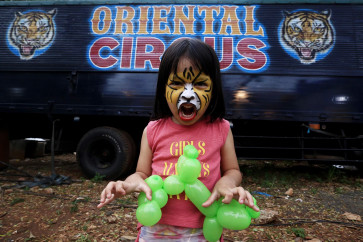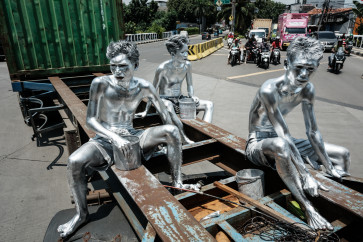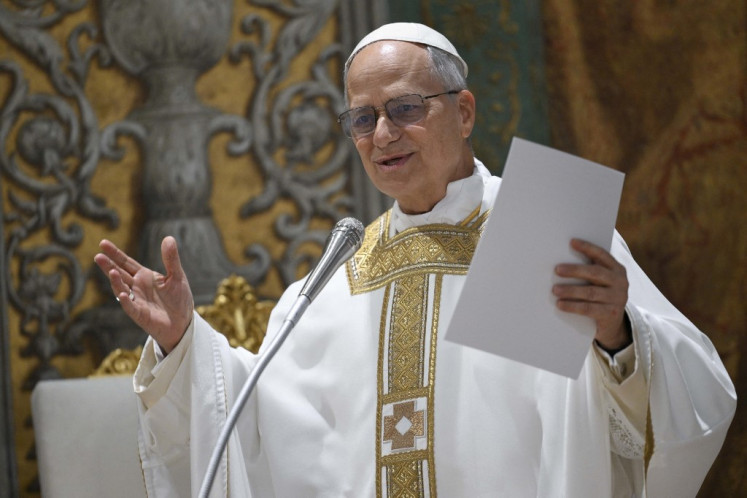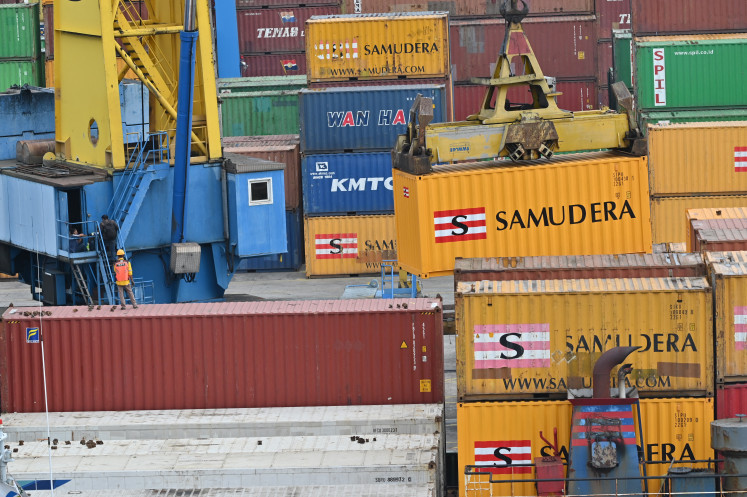Sunderland via Jakarta
Unsmiling: Portrait of a group of Javanese immigrants in Suriname who worked on the Marienburg plantation, circa 1890-1900
Change text size
Gift Premium Articles
to Anyone
 Unsmiling: Portrait of a group of Javanese immigrants in Suriname who worked on the Marienburg plantation, circa 1890-1900. (Julius Muller, Courtesy of the Tropenmuseum, Amsterdam)" border="0" height="278" width="498">Unsmiling: Portrait of a group of Javanese immigrants in Suriname who worked on the Marienburg plantation, circa 1890-1900. (Julius Muller, Courtesy of the Tropenmuseum, Amsterdam)
Unsmiling: Portrait of a group of Javanese immigrants in Suriname who worked on the Marienburg plantation, circa 1890-1900. (Julius Muller, Courtesy of the Tropenmuseum, Amsterdam)" border="0" height="278" width="498">Unsmiling: Portrait of a group of Javanese immigrants in Suriname who worked on the Marienburg plantation, circa 1890-1900. (Julius Muller, Courtesy of the Tropenmuseum, Amsterdam)From professional portraits, to documentary photography, analog film to smart phones and apps, photography has become an almost universal tool by which to record and share our daily experiences.
A recent event in Sunderland, North East England, âThe Social: Encountering Photographyâ was a wide-reaching festival that aimed to celebrate this global use of photography in all its diverse forms.
As part of this vibrant âsocialâ was a group exhibition The (Post) Colonial Photostudio 2 curated by UK-based Indonesian scholar Alexander Supartono from Sept. 28 to Nov. 23.
Showcasing the works of six artists from Indonesia, Thailand, Malaysia, Bangladesh, the UK and the Netherlands, the exhibition brings together works that respond to photographic devices used by Western colonizers to document native populations during periods of colonial rule in the mid-19th century. Each of the contemporary artists on display subverts these devices to investigate how they can still be used to ask questions about photography and self-image today.
 Family ties: A Chinese immigrant family in Suriname, 1890-1900. (Courtesy of the Tropenmuseum, Amsterdam)
Family ties: A Chinese immigrant family in Suriname, 1890-1900. (Courtesy of the Tropenmuseum, Amsterdam)
To provide visual context, the contemporary works are interspersed with historical sources that help to offset and draw out comparisons in the styles of photography â from the use of props and backdrops, to overtly âexoticâ poses.
The historical images also provide a sense of intrigue and romanticism not just for the human subjects, but for the analog process of photography itself, which in the current digital age, retains a great sense of nostalgia.
The work Study of Lampreyâs Malayan Male by Malaysian artist Yee I-Lann combines a historical source with her own reinterpretation, asking how our viewing gaze can be redirected in present times. The piece contains two framed images presented side by side.
The first is typical of those taken by Western settlers for anthropological and scientific study, with the subject presented naked in front of a gridded background. Itâs a difficult image to confront in a contemporary time frame, and this is emphasized by I-Lannâs response work of the same image, in which the subject is cut out and removed to leave a white silhouette, while the figure of the artist herself is transported in to seemingly gaze at the blank space left behind. The work seems to highlight a very human contradiction â our desire to look retrospectively at the past, but the struggle with what we may find there.
In his photo series Conversation with the Past, Dow Wasiksiri takes this link one step further and inserts himself into Javanese historical images. This literal attempt to converse with his ancestors at first seems absurdly humorous, as he cheerily offers his credit card to a fruit seller, or sits cross-legged opposite a studious young man, trying to tempt him to play Angry Birds on his iPad.
However, the longer you look at the images, an unnerving sense of corporate control in contemporary objects is clear. Every single prop used by Wasiksiri has some globalized connotation, from MacDonalds to viral Internet crazes.
As you realize this, questions begin to arise about whether we truly live in more progressive times, or whether our contemporary world is belittled through trivial objects and the drive for consumption.
 Solemn: A police officer with the Singkep Tin Company and his son in 1917. (Courtesy of Tropenmuseum, Amsterdam)
Solemn: A police officer with the Singkep Tin Company and his son in 1917. (Courtesy of Tropenmuseum, Amsterdam)
As a further illustration of this, Helen Marshall and Indonesian artist Risang Yuwonoâs series Project Tobong depicts one of the last Indonesian traveling theater troupes in their traditional costumes. Rather than being shown on stage, they are photographed at random outdoor locations â a traditional troupe cast out into the contemporary wild. Their dislocation at once refers to their nomadic performing nature, but also potentially to their increasing irrelevance in globalized contemporary society, a threat that seems to face all dwindling artistic traditions.
From documentary Indonesia, we are transported to the dreamscapes of Bangladeshi Samsum Alam Helalâs Love Studio. In this series, the photo-studio offers a chance for people to perform their dreams, against vibrantly painted backdrops and with their own control over props and pose. This is an opportunity for the subjects to escape from the banalities of real life, and it seems symbolic, not only of the escapist qualities that photography can grant, but of regaining control over photographic techniques previously used to exert Western rule.
On your way out, should you feel inspired by the dream poses pulled in Helalâs works, you are invited to pose in front of an enlarged image taken from Wasiksiriâs second series, in which locals at a market spontaneously pose for his temporary photo-studio in front of handheld fabric backdrops.
The (Post) Colonial Photostudio 2 is a thought-provoking study that demonstrates ways in which photographic techniques originally used to implement and confirm colonial power, have become freely used creative tools. Through Supartonoâs intuitive selection, we are shown how these contemporary photographers reference the past, but also offer commentary on contemporary life, individual representation and the position of photography today.
 Dreamscape: Untitled 1 (Love Studio Series), 2011. (Courtesy of Samsul Helal)
Dreamscape: Untitled 1 (Love Studio Series), 2011. (Courtesy of Samsul Helal)
 Thought provoking: Suddenly you are the focus of the world, 2012. (Courtesy of Dow Wasiksiri)
Thought provoking: Suddenly you are the focus of the world, 2012. (Courtesy of Dow Wasiksiri)
 Unnerving: Fancy a cup of Java, 2012. (Courtesy of Dow Wasiksiri)
Unnerving: Fancy a cup of Java, 2012. (Courtesy of Dow Wasiksiri)
 Unsmiling: <)
Unsmiling: <)
U
span class="caption" style="width: 496px;">Unsmiling: Portrait of a group of Javanese immigrants in Suriname who worked on the Marienburg plantation, circa 1890-1900. (Julius Muller, Courtesy of the Tropenmuseum, Amsterdam)
From professional portraits, to documentary photography, analog film to smart phones and apps, photography has become an almost universal tool by which to record and share our daily experiences.
A recent event in Sunderland, North East England, 'The Social: Encountering Photography' was a wide-reaching festival that aimed to celebrate this global use of photography in all its diverse forms.
As part of this vibrant 'social' was a group exhibition The (Post) Colonial Photostudio 2 curated by UK-based Indonesian scholar Alexander Supartono from Sept. 28 to Nov. 23.
Showcasing the works of six artists from Indonesia, Thailand, Malaysia, Bangladesh, the UK and the Netherlands, the exhibition brings together works that respond to photographic devices used by Western colonizers to document native populations during periods of colonial rule in the mid-19th century. Each of the contemporary artists on display subverts these devices to investigate how they can still be used to ask questions about photography and self-image today.

To provide visual context, the contemporary works are interspersed with historical sources that help to offset and draw out comparisons in the styles of photography ' from the use of props and backdrops, to overtly 'exotic' poses.
The historical images also provide a sense of intrigue and romanticism not just for the human subjects, but for the analog process of photography itself, which in the current digital age, retains a great sense of nostalgia.
The work Study of Lamprey's Malayan Male by Malaysian artist Yee I-Lann combines a historical source with her own reinterpretation, asking how our viewing gaze can be redirected in present times. The piece contains two framed images presented side by side.
The first is typical of those taken by Western settlers for anthropological and scientific study, with the subject presented naked in front of a gridded background. It's a difficult image to confront in a contemporary time frame, and this is emphasized by I-Lann's response work of the same image, in which the subject is cut out and removed to leave a white silhouette, while the figure of the artist herself is transported in to seemingly gaze at the blank space left behind. The work seems to highlight a very human contradiction ' our desire to look retrospectively at the past, but the struggle with what we may find there.
In his photo series Conversation with the Past, Dow Wasiksiri takes this link one step further and inserts himself into Javanese historical images. This literal attempt to converse with his ancestors at first seems absurdly humorous, as he cheerily offers his credit card to a fruit seller, or sits cross-legged opposite a studious young man, trying to tempt him to play Angry Birds on his iPad.
However, the longer you look at the images, an unnerving sense of corporate control in contemporary objects is clear. Every single prop used by Wasiksiri has some globalized connotation, from MacDonalds to viral Internet crazes.
As you realize this, questions begin to arise about whether we truly live in more progressive times, or whether our contemporary world is belittled through trivial objects and the drive for consumption.

As a further illustration of this, Helen Marshall and Indonesian artist Risang Yuwono's series Project Tobong depicts one of the last Indonesian traveling theater troupes in their traditional costumes. Rather than being shown on stage, they are photographed at random outdoor locations ' a traditional troupe cast out into the contemporary wild. Their dislocation at once refers to their nomadic performing nature, but also potentially to their increasing irrelevance in globalized contemporary society, a threat that seems to face all dwindling artistic traditions.
From documentary Indonesia, we are transported to the dreamscapes of Bangladeshi Samsum Alam Helal's Love Studio. In this series, the photo-studio offers a chance for people to perform their dreams, against vibrantly painted backdrops and with their own control over props and pose. This is an opportunity for the subjects to escape from the banalities of real life, and it seems symbolic, not only of the escapist qualities that photography can grant, but of regaining control over photographic techniques previously used to exert Western rule.
On your way out, should you feel inspired by the dream poses pulled in Helal's works, you are invited to pose in front of an enlarged image taken from Wasiksiri's second series, in which locals at a market spontaneously pose for his temporary photo-studio in front of handheld fabric backdrops.
The (Post) Colonial Photostudio 2 is a thought-provoking study that demonstrates ways in which photographic techniques originally used to implement and confirm colonial power, have become freely used creative tools. Through Supartono's intuitive selection, we are shown how these contemporary photographers reference the past, but also offer commentary on contemporary life, individual representation and the position of photography today.













